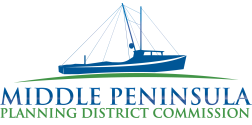As the 2019 hurricane season kicks off, property owners looking to shore up their waterfront with nature-based solutions can access funds through the Middle Peninsula Planning District Commission.
FOR IMMEDIATE RELEASE
SALUDA, VA – The Middle Peninsula region may have been spared potentially devastating blows during the 2018 hurricane season, but waterfront property owners throughout the region are encouraged to prepare now for potential storms in 2019 by stabilizing their properties with living shorelines, the Middle Peninsula Planning District Commission (MPPDC) announced this week.
To do so, residents can access a suite of funds available through the MPPDC’s low interest loan Living Shoreline Incentive Program and/or through grants provided by the Virginia Soil and Water Conservation Districts’ Virginia Conservation Assistance Program.
“In addition to providing shoreline stabilization and mitigating storm damage, living shorelines have proven to improve water quality,” said Del. Keith Hodges, who represents the Middle Peninsula.
Hodges has sponsored legislation to help provide the funding, tax exempt status, and permission for both businesses and residential property owners to access programs available to assist with living shoreline installations.
“With its vast knowledge, access to loan and grant funding, and understanding of the regulatory environment surrounding rural coastal waterfront property, the Middle Peninsula PDC has arguably the strongest living shoreline program in Virginia,” Hodges said.
Earlier this year, Virginia Gov. Ralph Northam released the Commonwealth’s plans for the third and final phase of a 15-year regional effort to clean up the Chesapeake Bay. Officially called the Phase III Watershed Implementation Plan, required by the U.S. Environmental Protection Agency, the plan commits Virginia to innovative solutions aimed at reducing nutrients and sediments released into the Chesapeake Bay.
According to the Federal Emergency Management Agency, in its draft National Mitigation Strategy, living shorelines “can improve water quality and quantity by reducing storm water runoff and treating it at its source; reduce pollutant loads discharged in combined sewer overflows; reduce flood risk; and provide water for outdoor irrigation or recharging groundwater.”
The MPPDC’s Living Shoreline Incentive Program funds are offered in the form of loans of $1,000 to $10,000 financed for up to 60 months, and for up to 120 months for loans greater than $10,000. Interest rates are set at the Wall Street Journal Prime Rate as of the day of loan approval.
Soil and Water Conservation Districts can provide grant funding reimbursed at 75% of total costs with a maximum payment of $15,000 per parcel per year.
Middle Peninsula waterfront landowners interested in accessing grant funds to construct living shorelines should contact either the Tidewater or the Three Rivers Soil & Water Conservation District for more information, advised Department of Conservation and Recreation Director Clyde Cristman.
“The threats of storms to our region are inevitable and this is a way we can help property owners and the region enhance the resilience of our shorelines while also doing our part to continue to contribute to improving water quality,” said Lewie Lawrence, MPPDC Executive Director.
Living shorelines can include the installation of the following:
- Native plant roots along shorelines hold soil in place to reduce erosion, provide a buffer to upland areas, break small waves and slow inland water transfer.
- Edging structures, which can include living reefs, hold the toe of existing or vegetated shoreline and protect against further shoreline erosion.
- Installed parallel to existing or vegetated shorelines, sills reduce wave energy.
- Beach nourishment. Adding sand from an outside source to an eroding beach can move the shoreline seaward.
- A combination of any of the above.
An especially unique feature of the MPPDC incentive program, Lawrence said, is that it also “insures” the living shorelines by providing replacement costs of any plants that fail to take within the first two years of the project.
Homeowners looking to begin the loan process, or get direction in accessing grant funds, should reach out to MPPDC staff to discuss program eligibility. Following discussions with the Virginia Marine Resources Commission on site suitability, property owners will fill out an application, which is available at mppdc.com. For more information contact Julie Kaylor at This email address is being protected from spambots. You need JavaScript enabled to view it. or (804) 758-2311.
ABOUT THE MIDDLE PENINSULA PLANNING DISTRICT COMMISSION
The Middle Peninsula Planning District Commission (MPPDC) is one of 21 planning commissions in Virginia charged with promoting the orderly and efficient development of the physical, social and economic elements of the district by planning, and encouraging and assisting localities to plan, for the future.
The MPPDC is comprised of the six counties (Essex, Gloucester, King and Queen, King William, Mathews, and Middlesex) and three towns (Tappahannock, Urbanna, and West Point) on the Middle Peninsula.
Commissioners are appointed by each locality and consist of two elected and one citizen member for each county and one elected member for each town. Three county administrators and one town manager serve on the Commission on a rotating basis. The Executive Director/Secretary, selected by the Commission, manages the daily operations of the planning district's professional staff.
MPPDC is funded by annual contributions from its member local governments, by appropriations from the Virginia General Assembly, and by grants from state and federal governments and other entities.
MPPDC prepares an annual work program and budget each year determined by the needs and priorities of the region and available funding opportunities.
For more information about the Middle Peninsula Planning District Commission, contact Lewie Lawrence at This email address is being protected from spambots. You need JavaScript enabled to view it. or (804) 758-2311.
